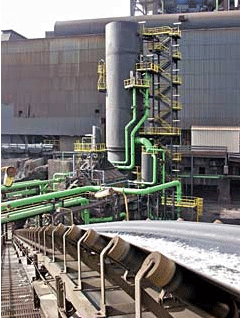
|
 |
 Home > Product Information > Sekyung Corporation > Equipment Home > Product Information > Sekyung Corporation > Equipment |
|
|

Handling of blast furnace slag is an important aspect of modern blast furnace operation. Today, blast furnace slag is a
saleable product (granulated slags and for production of cement) rather than a difficult and costly waste material.
We has developed slag granulation process (incorporating our proprietary dynamic dewatering drum) as the most popular and effective means of processing blast furnace slag in the world today.
The process is highly flexible; and the compact sub-plant can be applied to any furnace configuration. Granulation,
dewatering and storage of the slag can be done adjacent to the furnace or can be split up to suit available plant space
or logistics. With the dynamic nature of the process (slag is granulated and dewatered at the tapping rate from the
furnace) the operator can receive slag flowrate data from plant. This data is useful in controlling and
optimising the blast furnace process. Important Benefits:
Very compact design offering maximum flexibility in the layout of installations adjacent to the cast floor of the blast
furnace. With an adequate layout of the hot runners on the cast floor, or through the introduction of an additional
remotely located second granulation tank, one granulation unit can handle the slag of two tap holes.
Continuous filtering and evacuation of dewatered slag sand up to its storage facility without interruptions for purging.
Low fines content in the closed loop water circuit
High reliability
Measurement of slag flow, due to the design of the drum and the dewatering process.
Flexibility of the plant operation to be largely independent from blast furnace operations, such as tapping time duration,
inter-cast gap time, minimum and maximum slag flows, etc.
Air pollution control through closed loop water circuits and reduced emissions
Low investment costs compared to static and other dynamic dewatering systems.
Low wear on drum body and therefore life time in excess of one BF campaign – due to virtually no relative movement
between slag and the dewatering equipment.
Low maintenance cost due to low wear.
Low operation costs due to low energy consumption, simple design and fully automatic operation.
|
| |
 |
| |
|
|
|